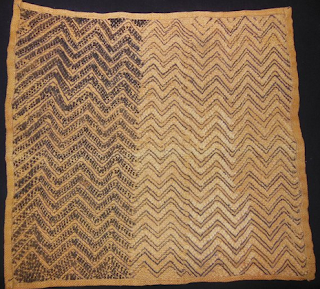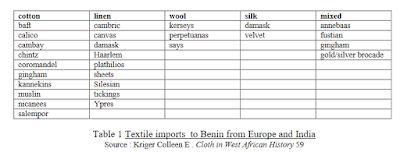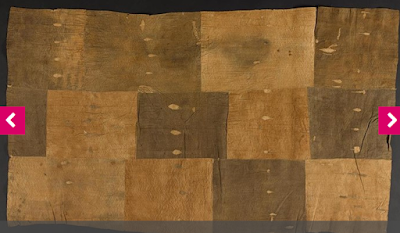Sunday, September 9, 2018
Pagne Kuba
In sub-Saharan Africa, where representative art has flourished for centuries, carvers and crafts people have typically taken for their subjects human figures, animals, plants, and elements of the natural world. Abstract art, meanwhile, has remained marginal. The textiles of the BaKuba (Kuba) people of the Democratic Republic of Congo are an exception. Although part of a tradition that stretches back 400 years, Kuba textiles have a strikingly modern look. They use improvised systems of signs, lines, colors, and textures, often in the form of complex geometric rectilinear patterns. Their appliqués are reminiscent of works by 19th- and 20th-century masters like Matisse, Picasso, Klee, Penck, and Chellida. This is no coincidence: all of those artists were inspired by Kuba design!"
"The most commonly known of the Kuba textiles are the cut-pile Shoowa or Kasai Velvets, named after the river along which the BaKuba live. Improvisation and irregularity characterize the Kasai Velvets. This is because the weaver works without a plan or preliminary sketching, though the model can occasionally be displayed on the cloth in advance using black thread. Often the design is built up from memory, repeating the most common designs and color combinations found in the region. The message conveyed is up to the artist, who is the only one who can explain what he or she intended to represent."
"Originally Kasai Velvets were used as currency, and were valuable products for trade and exchange. They could be included in the tribute villagers paid annually to the King, in the dowries of matrimonial exchanges, and in funeral gifts and offerings to the dead. They also served to embellish the royal court, cover the royal thrones, and decorate the King’s palace wall. Colonial agents and missionaries arriving in the Kuba Kingdom in the nineteenth century were fascinated by the Kasai Velvets, and encouraged women to produce more of them to adorn religious vestments for Catholic missionaries and decorate the interiors of European houses." This piece measures 18" x 20"
Friday, September 7, 2018
The Dress of Makoti
This is an example of the dress of makoti. To show respect and submission to the authority of her husband and parents-in-law, traditional practice dictated that a newly-married Xhosa woman would wear her ikhetshemiya (headcloth) low over her forehead, keep her shoulders covered, cover her hips with a blanket and wear a isishweshwe skirt and apron. She should stay with her parents-in-law for up to a year, a period during which her behaviour conveyed that she adhered to ukuhlonipha traditions of respect. Aspects of this practice are still present but are being eroded with urbanization. Head cloth, blanket and towel on loan from Siphokazi Mesele, nee Lindelwa Pamela Mbola, who wore them when she was makoti.
Blaudruck
Simplified resist-dyeing techniques were used to create a fabric of
small, white, regularly spaced patterns on a deep blue background. This
was known in Germany as 'blaudruck' (blue print). This fabric was
transformed into garments for work-wear and peasant-wear, and became
associated with European regional and Protestant dress, as well as
expressing nationalist sentiments. When German missionaries and traders
immigrated to the Eastern Cape and other parts of southern Africa during
the mid-1800s, they brought their 'blaudruck' with them and traded with
those they came in contact with. It became popular amongst women on
mission stations. This fabric was later adopted by IsiXhosa women in the
Eastern Cape to produce garments.
Indienne
One of the oldest artefacts in the isishweshwe collection, this dress is
an example of 'Indienne'. It is made of Indian cotton (chintz or
calico) and has a continuous pattern of delicate intertwined stems
bearing leaves and flowers. The dress originated on the Coromandel coast
of India in the third quarter of the 18th century. Indian chintz was
extremely popular throughout the eighteenth century, and was imported
into the Netherlands by the Dutch East India Company, thus making it
available at the Company's halfway station at the Cape.
IsiShweshwe and Colonialism
The
cloth known as amajamane, amajerimane or isishweshwe has its origins in
the East, and was originally made from cotton and blue dye from the
indigo plant. Through trade, it spread to different parts of the world
including the Cape, where it was initially worn by slaves, Khoisan and
colonialists. The earliest origins of isishweshwe can be traced back to
the craze for colourful indiennes (Indian cottons) which spread like
wildfire across Europe from the mid-1600s. The complicated techniques
for making multi-coloured indiennes in Central Europe were eventually
adapted to the use of one colour only: indigo.
Thursday, September 6, 2018
Wednesday, September 5, 2018
Raffia
Possibly Teke artist
Raffia cloth
(nkuta)
Date: Early 20th century
Medium: Raffia
Dimensions: H x W: 33.2 x 28.3 cm (13 1/16 x 11 1/8 in.)
Credit Line: Gift of S. M. Harris
Geography: Lower Congo-Kasai River region, Democratic Republic of the Congo
Object Number: 99-13-47
Search Terms:
Funerary
Trade
Object is not currently on exhibit
Woven
goods, such as cloth strips and fiber mats, were used in parts of
Africa as currency. Parties of the transaction used variations in width
and the quality of the weave as a means to negotiate value. Cloth was
also frequently used in connection with other currencies, such as brass
rods, thus lending additional leverage to the negotiation. Cloth or mats
of more or less uniform size were used for gifts, peace offerings,
payment from a son to his father upon attaining adulthood and payment
upon the birth of a child or the burial of a parent. Cloth currency was
also used as a tribute for a spouse who remained faithful or, by
contrast, as a penalty for adultery. In central Africa raffia woven
mats, stored flat or rolled into bundles, were a popular form of cloth
currency in the late 19th and early 20th century. Among the Teke
peoples, funerals of the wealthy and nobility required raffia cloths not
merely to cover the body but in abundance to ensure a proper status in
the "village of the dead."
Cloths with Names’: Luxury Textile Imports in Eastern Africa, c. 1800–1885
In the nineteenth century, a vast area of eastern Africa stretching the
length of the coast and into the reaches of the Congo River was
connected by long-distance trade mostly channelled through the Omani
commercial empire based in Zanzibar. As studies have recently shown, a
critical factor driving trade in this zone was local demand for foreign
cloth; from the 1830s the majority of it was industrially made coarse
cotton sheeting from Europe and America, which largely displaced the
handwoven Indian originals. Employing archival, object, image and field
research, this article demonstrates that until 1885 luxury textiles were
as important to economic and social life in central eastern Africa,
textiles known to the Swahili as ‘cloths with names’. It identifies the
thirty or so varieties which élites — and, increasingly, the general
population — selected for status dress and gifts, instrumental in
building the commercial and socio-political networks that linked the
great region. Finally, it shows that the production and procurement of
most varieties remained in the hands of Asian textile artisans and
merchants; most prestigious and costly were striped cotton and silk
textiles handcrafted in western India, and in the southern Arabian
nation of Oman. European industrial attempts to imitate them were
hampered by several factors, including their inability to recreate the
physical features that defined luxury fabrics in this region — costly
materials, rich colours, complex designs and handwoven structures.
"Gabon" Textile
"Gabon" Textile
- Designer:
- Nathalie du Pasquier (French, born Bordeaux, 1957)
- Manufacturer:
- Rainbow, Milan
- Date:
- 1982
- Medium:
- Cotton
- Dimensions:
- 55 in. × 13 ft. 3 in. (139.7 × 403.9 cm)
- Classification:
- Textiles-Painted and Printed
- Credit Line:
- Gift of Geoffrey N. Bradfield, 1986
- Accession Number:
- 1986.398.3
- Nathalie du Pasquier was a founding member of Memphis. Barbara Radice, Sottsass’s partner, describes her as "a kind of natural decorative genius—anarchic, highly sensitive, wild, abstruse, capable of turning out extraordinary drawings at the frantic pace of a computer. . . . [Her works] are enthusiastic, explosive, exalted, elated, as striking as neon in a tropical night." Du Pasquier’s complex repeating patterns embrace all manner of influences, including African textiles, Cubism, Futurism, Art Deco, and graffiti. This work belongs to a series based on African patterns. Other designs are titled Kenya, Zaire, and Zambia.
Tuesday, September 4, 2018
Jadis
chaque
tribu
était
plus
ou
moins
spécialisée
dans
tel
ou
tel
artisanat;
les
Baduma
et
les
Mitsogo
excellaient
dans
la
confection
de
tissus
de
raphia
(ibongo),
les
Ngowè
dans
le
tissage
des
nattes
fines
à franges
(tava
yi
N gowe)
,
les
Batsangui
dans
le
travail
du
fer
(imyanga).
Ainsi,
jusqu'à
ces
derniers
temps,
les
Adyumba
étaient
renommés
comme
fabriquants
de
poterie
(ambono).
Sunday, September 2, 2018
Saturday, September 1, 2018
Wednesday, August 29, 2018
Sunday, August 19, 2018
Les raphia Haut Ogooue
appelés suivant leur grandeur: Latsoulou (tout petit), Lapogho (un peu plus grand). ll en existe en fibres plus grossières tel le "Nta", c'est un pagne de 21 mètres pouvant servir de linceul. Les nattes étaient soit Okouraga (pour le séchage de ..
Le raphia chez les téké
Le raphia est un tissu d´origine Batéké, confectionner à partir des fibres très fines de palmiers en bordures de rivières, "mfoumfoulou". La feuille d´ananas fournissait des fils d´une grande finesse, plus clairs que les folioles de palmiers, mais aussi plus courts. L´on se sert généralement de jeunes feuilles de palmiers. On le tisse à sec après une opération de décorticage.
Teinté de quelques franges de fibre rouge, il est réservé aux dignitaires. Les pagnes plus larges sont de fabrication tardive, composés de quatre rangées de pièces de taille variées, cousues par une couture rabattue, ménagent autant de rangs de franges. Des plis permettent d´utiliser les deux côtés frangés de chaque pièce, afin d´augmenter l´épaisseur de cette parure.
Le raphia est aussi réservé aux grandes manifestations, pour les rites et comme tenues cache sexe (bilielé). On trouve cependant tout une variété de design attribuée au tissu en raphia. Les Batékés par exemple, présentent parmi tant d´autres échantillons,
- Mpou, ndzou, indzindjou : Généralement, pagnes réservés aux dignitaires, de par leur appellation mpou qui révèle le pouvoir, la puissance reflètant le Nzam´a mpou c´est à dire le "Dieu tout puissant",
- Mfoumfoulou : tissu raphia de fibres très fines,
- Tergal : À cause du tissage qui ressemble à la technique utilisée, comparée au tissu tergal.
- Ndouo na : Dont la confection à quatre franges de fibres reflète une couture très rabattue du tissu raphia.
- Limi : Ainsi appelé à cause de sa confection qui fait ressortir des stries saillantes comparables à celle d´une lime à étancher les couteaux et bien d´autres instruments.
Thursday, August 16, 2018
Anta
Le
tissage
de
raphia
produisait
des
couvertures
grossières
(anta),
des
caloUes,
et
des
pièces
plus
fines
(pogo)
qu'on
cousait,
jusqu'à
douze
ensemble
pour
faIre
des
toges
pour
les
hommes
et
des
pagnes
noués
sous
les
bras
pour
les
femmes.
Ces
tissus
de
raphia
étaient
le
principal
objet
d'échange
extérieur
avec
les
Mbochi,
les
Téké
de
l'Alima,
les
Kou-
kouya.
II
y
avait
des
marchés
intérieurs
pour
la
viande,
les
poulets,
les
marmites
en
terre,
les
calebasses.
Les
Téké
fabriquaient
du
sel
végétal.
kipali
Le raphia, au contraire, était beaucoup plus intégré à l’ensemble de la formation sociale au niveau de tous les groupes de filiation et de résidence. Il finit par s’imposer à son tour comme monnaie principale (ou peut-être à le redevenir). Diverses étapes marquèrent le processus. On connut d’abord les nta (= 30 tissus simples). 50 nta. Puis, Une compensation matrimoniale valait ce furent les pagnes bvarika (= 15 tissus). Une compensation valait 30 bvarika (43). Énfin les nzwuona. Une compen- sation s’élevait à 7 mubuoni, soit 140 nzwuona. L’adultère: 100 nzwuona (donc en baisse relative). Quand on sait qu’un nzwuona est formé de 16 tissus simples ntsulu, il est facile de déduire que la compensation de mariage finale .?‘était accrue considérablement (malgré l’incertitude qui pèse sur certains chiffres). D’autre part, nous trouvons confirmation de la spécialisation et du développement croissant du tissage. “On a changé de tissus de raphia - comme monnaie - parce qu’ils étaient de plus en plus beaux. ”
Nta
Pour
notre
interlocuteur,
un
nta
comprenait
alors
30
tissus
de
raphia
simples,
soit
plus
d’une
semaine
de
travail,
en
comptant
le
ramassage,
la
préparation
du
raphia,
le
tissage.
Sur
ces
bases,
une
houe
équivalait
à
une
semaine
et
demie,
une
machette
à
une
demi-semaine.
On
a
donc
de
fortes
concentrations
de
travail
relatives.
Ce
qui
importe
n’est
pas
d’imaginer
un
tisserand
seul
au
monde
en
train
de
tisser,
mais
d’éprouver
la
réalisation
véritable
d’un
tel
surplus
dans
la
formation
sociale.
L’investissement productif trouvait vite ses limites.
L’investissement productif trouvait vite ses limites.
Mantsiene
nta nzwouna semi specialisees
Les riches (quand ils se distinguent) (nta, nzwuona) et sont faits par - des hommes semi-spécialisés. Les pagnes ordinaires (bvarika) par- viennent aux femmes, enfants et subordonnés pauvres par réparti- tion des chefs de hameaux. On peut ajouter deux considérations: chaque système dominant 111: puis II, englobe aussi des biens tissés des systèmes inferieurs. Ainsi II comprendra aussi des bvarika et II incluera toutes les formes de pagnes existantes. Cependant, les pagnes englobés sont alors, malgré le maintien de leurs dénominations, associés à des statuts opposés dans la production comme dans la répartition. Comme le résuma fort pertinemment notre orateur, “tous ces pagnes, nous les avons connus dans nos dots anciennes” (en met- tant à part le pagne de la panthère, qui peut servir dans le ma- riage d’un seigneur du ciel 1. Quand on sait 1’ ampleur des pres- tations funéraires en pagnes, on mesure combien le tissage cris- tallise directement le surtravail féminin (en particulier agricole) mais aussi le travail masculin (Ngoulou 198
raphia
BRANCHES
D’ACTIVITE
ANNEXES
Les
pièces
de
raphia
tissées
avec
cet
instrument
sont
petites:
le
module
ordinaire
est
de
45
cm
sur
75
cm.
C’est
en
cousant
en-
suite
ces
rectangles
qu’on
confectionnera
des
pagnes
de
taille
variée.
Ce
procédé
est
identique
à
celui
que
décrivait
l’ethnologue
italien
Pecile
(“un
piccolo
telajo
assai
ingegnoso,
fatto
su110
stesso
principio
dei
nostri
telai
primitive,
serve
a
tessere
i
quadrati
di
stoffa
cui
‘accennai
e
che
vengono
poi
cuciti
insieme”:
1887:450).
J’aurai
l’obligation
de
revenir
plus
en
détail
sur
les
diverses
utilisations
des
tissus,
étant
donné
l’importance
qu’ils
avaient
tant
dans
l’économie
interne
des
Kukuya
que
dans
leurs
exportations
;
rappelons
seulement
pour
l’instant
les
deux
usages
principaux
des
‘pagnes
ou
tissus
de
raphia
à
l’intérieur
du
pla-
teau:
on
les
accumulait
pour
former
les
compensations
matrimo-
niales
et
les
amendes
de
‘toute
nature.
Ces
tissus
restaient
toujours
convertibles
en
ressources
alimentaires.
On
distinguait
entre
deux
catégories
de
pagnes
de
raphia:
d’une
part
les
nombreuses
varié-
tés
courantes,
faites
d’une
combinaison
de
plusieurs
tissus
simples
(litsulu),
vé
aux
d’autre
part
le
ntango
(“tissu
de
la
panthère”),
réser-
seigneurs
du
ciel.
Ce
dernier
est,
lui
aussi,
composé,
comme
l’exige
le
caractère
du
métier
à
tisser,’
de
plusieurs
pagnes
ayant
les
dimensions
du
module;
mais
ceux-ci
sont
richement
déco-
rés
suivant
des
motifs
connus
et
relativement
fixés.
En
ce
cas,
la
“pièce”
de
base
de
ce
remarquable
ensemble
se
nomme
litsulu
li
ngo.
La
composition
du
n)ango
réclame
une
technique
beaucoup
plus
longue
et
élaborée,
necessltant
la
connaissance
des
couleurs
végétales
servant
à
inscrire
les
motifs.
Raphia
Un seigneur du ciel et de la terre Akolo il porte son raphia, il tient son balaie de justice, sa hache rituel.
Ntango
Le pagne porté exclusivement par les chefs, Nta qui veut dire pagne et Ngo panthère. Décoré avec les motif de la panthère, la représentation des champs de manioc et parfois les objets mpu. Ce produ, Seul lit remarquable eu égard a la technique presque immuable se trouve réservé aux Seigneur du ciel. Seul les experts étaient en mesure de faire un tango. (les kukuya )
October 2, 2015
Dora Thornton, Curator of Renaissance Europe and the Waddesdon Bequest, British Museum
Dora Thornton, Curator of Renaissance Europe and the Waddesdon Bequest, British Museum
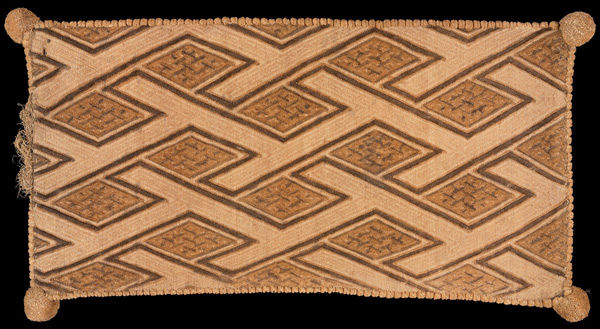
Luxury Cloth: Cushion Cover,
17th–18th century, inventoried 1883. Kongo peoples; Kongo Kingdom,
Democratic Republic of the Congo, Republic of the Congo, or Angola.
Raffia, pigment; 9 1/2 x 18 1/2 in. (24 x 47 cm). Pitt Rivers Museum,
University of Oxford (1886.1.254.1)
One of the wonders of Kongo: Power and Majesty,
on view through January 3, 2016, is the group of luxury textiles finely
woven from golden palm fiber, then hand-cut and rubbed in the weaver's
hands. The result is a rich interplay of tone and texture that reminded
me at first of aerial views of crop circles cut into fields of ripening
grain.The textiles, however, are far more complex as virtuoso pieces. Their making was described with admiration by Antonio Zuchelli (1663–1716), an Italian missionary to the Kongo. He notes how the local weavers finished their cloth "with a knife they cut the cloth in the proper spots and rub it well with their hands, so that it looks like patterned velvet." Europeans compared what they saw to luxurious Italian silk velvets with elaborate woven patterns, but they admired pieces that were "so beautiful," in the words of the Portuguese sea captain Duarte Pacheco Pereira (ca. 1460–1533), "that those made in Italy do not surpass them in workmanship." What really surprised them was the way in which Kongo cloths were woven not from silk but from raffia, which made them miraculously soft to the touch. The designs were less often a source of comment, although in 1656, John Tradescant the Younger (1608–1662) described a cloth in his museum in Lambeth—now in the Pitt Rivers in Oxford—as "A Table-cloath of grass very curiously waved."
When one looks at these luxury textiles with twenty-first-century eyes, the timeless artistry of the design is particularly striking. Bands of sophisticated geometric patterns spiral across the textile surfaces, similar to the interlace patterns on Kongo ivory oliphants, which are carved from curving elephant tusks. Such repeating motifs were not merely decorative but had profound significance within Kongo society. Exhibition curator Alisa LaGamma explains in her introductory chapter to the exhibition catalogue how the spiral movement is a visual metaphor for the path taken by the dead, which is central to Kongo thought and imagining. That concept communicates through the finished designs, explaining why these were elite display pieces in Kongo society, and why they were an important component in diplomatic exchanges with the Portuguese from the fifteenth century.
An interesting puzzle—and a prompt to further research—is the European format of the cloths themselves, which are shaped to European taste in their format and structure. Even the elaborately made pompoms at their corners imitate those made of silk or wool on European cushions. A fascinating insight into the status of luxury cushions within an Italian, early fifteenth-century context is provided by the Salimbenis' fresco from Urbino showing scenes from the life of Saint John the Baptist.
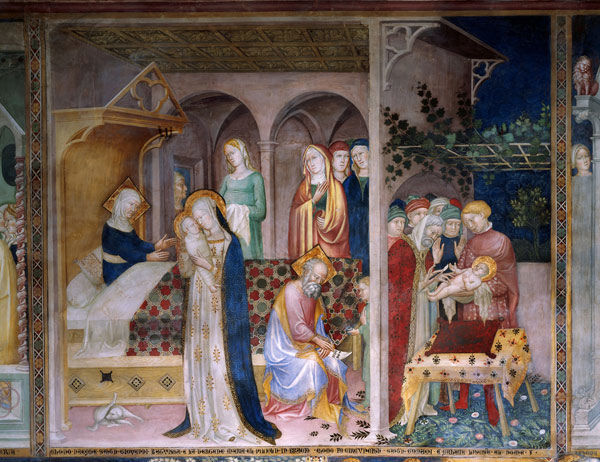
Lorenzo and Giacomo Salimbeni (Italian, ca. 1374–ca. 1416). Scenes from the Life of John the Baptist (Birth and Circumcision) (detail), ca. 1416. Fresco. Oratorio di San Giovanni Battista, Urbino, Italy
The infant Saint John has been presented for circumcision by the rabbi on an Italian-made red cushion which, with the fine tablecloth and superb coverlet, shows the importance of such accessories as badges of status. This was the kind of context within which the Kongo luxury cloths were understood when they first arrived in Europe.
Some of the finest surviving Kongo cloths are still to be found in collections formed in Europe from the sixteenth to the eighteenth century. Known as Kunstkammern, or "art rooms," these cabinet collections at first concentrated mostly on small-scale European treasures that were precious and intricate or demonstrated skill or virtuosity. But during the sixteenth century, in the so-called Age of Exploration, these collections diversified to explore all things curious, rare, and exotic that had been brought from an expanding range of global contacts. What were Europeans to make of what Shakespeare unforgettably called the "brave new world" opening up all around them?
From Stockholm to Florence, London to Prague, Kongo luxury cloths were preserved in court and cabinet collections formed by rulers, princes, and urban elites. The first two recorded examples appear in Prague in 1607—in the Kunstkammer of the Holy Roman Emperor Rudolf II of Prague (r. 1576–1612), where they remain today—but the royal houses of Sweden and Denmark swiftly followed.
Kongo cloths are also recorded in the seventeenth century as prize pieces acquired by doctors, scientists, and scholars. The Milanese physician Ludovico Settala (1552–1633) and his son Manfredo (1600–1680) formed one of Italy's most famous scientific museums, which included several examples. There is a drawing of a folded one, annotated as "a small mat to make a cushion to sit on, made of straw of rare beauty…made in Angola or Congo." Settala's scholarly network included the Jesuit scholar Athanasius Kircher (1602–1680), founding director of the the Musaeum Kircherianum in Rome, who acquired pieces described in 1709 as "four mats made with admirable skill in the Kingdom of Angola….they look like a silk cloth notwithstanding they are made of very thin palm threads."

C.F. (Cesare Fiore; Italian, 1636–1702). Luxury Cloth: Cushion Cover in the Catalogo del Museo Settala, mid-seventeenth century. Watercolor. Biblioteca Estense Universitaria, Modena (vol. 1, ms. 17)
Sir Hans Sloane (1660–1753), physician and second president of the
Royal Society—whose collection was to become the foundation of the
British Museum in 1753—owned two pieces that are listed in his
manuscript inventory and which still survive in a battered state. An
oblong cushion in much better condition, also in the British Museum, was
only acquired much later and illustrates the rise of ethnography as a
discipline in the nineteenth century, which led to the fragmentation of Kunstkammern all over Europe. It was first inventoried in the Royal Danish Kunstkammer
in 1674 but was deaccessioned by the Nationalmuseet in Copenhagen and
acquired by the Quaker and abolitionist Henry Christy (1810–1865), who
gifted it to the British Museum.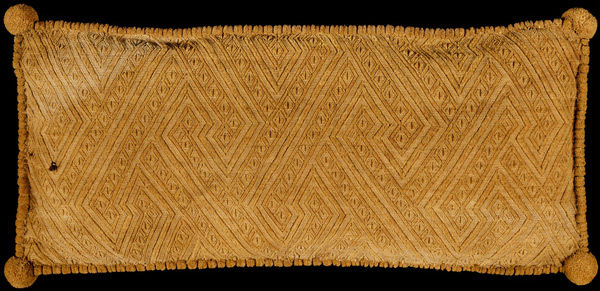
Luxury Cloth: Cushion Cover,
16th–17th century, inventoried 1674. Kongo peoples; Kongo Kingdom,
Democratic Republic of the Congo, Republic of the Congo, or Angola.
Raffia; 9 x 20 7/8 in. (23 x 53 cm). British Museum, London
But how were these cloths originally acquired? We are slowly finding
out more about the web of European dealers, the international trading
companies, and the merchants who supplied collectors, but the cultural,
political, and trading exchanges in which textiles first changed hands
in Kongo itself are still a mystery. Did European visitors bring
examples of their own cushions to Kongo and commission copies in local
materials and techniques? Or did Kongo leaders commission them as items
of commerce, exploiting new markets? Either way, their presence in
European collections from the sixteenth century attests to the
fascination they aroused as virtuoso textiles, which made distant worlds
tangible.Wednesday, August 15, 2018
Les differents textilles
Le cheik
Les pagnes bordes
Les pagnes non bordes
Les pagnes du dessus
ndèngui
limenea
mbongos
Guinées
Ntango
Okouwre
Gombe
Le pagne du chef
indiennes
raphia moelleux Apimdji
raphia a l ananas
raphia au crochet
raphia imprimé
Raphia en soie
Raphia en lin
Raphia metalique
soie
indigo
Peaux
fibres
synthetiques
Polyster
Cretones
Organza
Boston or massachussety
Bantsuali les tissus de traite nkami couvertures rouges nta grands pagnes de raphia “chez les Kukuya, on tisse l’étoffe indigène (de raphia) la plus fine; elle est très recherchée et vendue extrême- ment cher” (ibid. 1. Pecile nous en décrit la technique et signale que “les Kukuya sont des maîtres de cet art; les pagnes raffinés dont se servent le roi Makoko (Tiol et ses épouses proviennent de ce pays” (Pecile 1887:450 et suiv).
Les pagnes bordes
Les pagnes non bordes
Les pagnes du dessus
ndèngui
limenea
mbongos
Guinées
Ntango
Okouwre
Gombe
Le pagne du chef
indiennes
raphia moelleux Apimdji
raphia a l ananas
raphia au crochet
raphia imprimé
Raphia en soie
Raphia en lin
Raphia metalique
soie
indigo
Peaux
fibres
synthetiques
Polyster
Cretones
Organza
Boston or massachussety
Bantsuali les tissus de traite nkami couvertures rouges nta grands pagnes de raphia “chez les Kukuya, on tisse l’étoffe indigène (de raphia) la plus fine; elle est très recherchée et vendue extrême- ment cher” (ibid. 1. Pecile nous en décrit la technique et signale que “les Kukuya sont des maîtres de cet art; les pagnes raffinés dont se servent le roi Makoko (Tiol et ses épouses proviennent de ce pays” (Pecile 1887:450 et suiv).
Coton Anglais
 Ce tissu fut très apprécié par les gabonais au XIXe siècles.Une femme gabonaise qui se respecte dans
Ce tissu fut très apprécié par les gabonais au XIXe siècles.Une femme gabonaise qui se respecte dansLe Mpondé
 Le tissu est fait a partir des écorces battues provenant d' un fiscus et
parfois mélangés avec le coton ou la laine pour le rendre souple.Les
premiers Habitants du Gabons s'habillaient en tissus d’écorces battues.
Le tissu est fait a partir des écorces battues provenant d' un fiscus et
parfois mélangés avec le coton ou la laine pour le rendre souple.Les
premiers Habitants du Gabons s'habillaient en tissus d’écorces battues.
Le tapa gabonias lourd est bien pour les ameublements et décorations.
Le dikonzi

Le Ngombu, masieli,ndengi,
Étoffes punu en raphia sous forme de patchwork en composé de plusieurs étoffes de raphia.Onamba
Tissus riche M'pongoue qu'on utilisait comme dessus.Le Madras Gabonais

Le Boston

Le Manchester

L'original et les africains.
Dutch Wax
Le coton brodé

Pagne rénovation

Je suis à la recherche des tissus traditionnels Gabonais , s'il vous plait si vous en connaissez le nom et les fibres qui les constituent faites-le moi savoir.
C'est une longue bataille mais on arrivera.
Contact-moi:
mujabitsi@hotmail.com
Subscribe to:
Comments (Atom)
